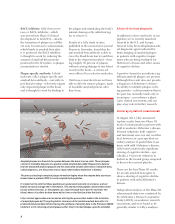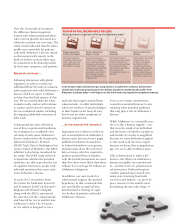Eli Lilly 2012 Annual Report Download - page 20
Download and view the complete annual report
Please find page 20 of the 2012 Eli Lilly annual report below. You can navigate through the pages in the report by either clicking on the pages listed below, or by using the keyword search tool below to find specific information within the annual report.
8
yet entirely clear, and will depend on a number of regulatory and marketplace factors that are still
developing.
• In the U.S., the FDA has the authority to grant additional data protection for approved drugs where the
sponsor conducts specified testing in pediatric or adolescent populations. If granted, this “pediatric
exclusivity” provides an additional six months, which are added to the term of data protection as well
as to the term of any relevant patents, to the extent these protections have not already expired.
• The FDA also has authority to grant "orphan" status to a specific use of a drug. Under the U.S. orphan
drug law, a drug or biological product can receive "orphan" designation if it is intended to treat a
disease or condition affecting fewer than 200,000 people in the U.S., or affecting more than
200,000 people but not reasonably expected to recover its development and marketing costs through
U.S. sales. Among other benefits, orphan designation entitles the drug to seven years of market
exclusivity, meaning that the FDA cannot (with limited exceptions) approve another marketing
application for the same drug for the same indication until expiration of the seven-year period. Unlike
pediatric exclusivity, the orphan exclusivity period is independent of and runs in parallel with any
applicable patents.
Outside the major markets, the adequacy and effectiveness of intellectual property protection for human
pharmaceuticals varies widely. Under the Trade-Related Aspects of Intellectual Property Agreement (TRIPs)
administered by the World Trade Organization (WTO), more than 140 countries have now agreed to provide
non-discriminatory protection for most pharmaceutical inventions and to assure that adequate and effective
rights are available to patent owners. Because of TRIPs transition provisions, dispute resolution mechanisms,
and substantive limitations, it is difficult to assess when and how much we will benefit commercially from this
protection.
Certain of our Elanco animal health products are covered by patents or other forms of intellectual property
protection. In general, upon loss of effective market exclusivity for our animal health products, we have not
experienced the rapid and severe declines in revenues that are common in the human pharmaceutical
segment.
There is no assurance that the patents we are seeking will be granted or that the patents we hold would be
found valid and enforceable if challenged. Moreover, patents relating to particular products, uses,
formulations, or processes do not preclude other manufacturers from employing alternative processes or
marketing alternative products or formulations that compete with our patented products. In addition,
competitors or other third parties sometimes may assert claims that our activities infringe patents or other
intellectual property rights held by them, or allege a third-party right of ownership in our existing intellectual
property.
Our Intellectual Property Portfolio
We consider intellectual property protection for certain products, processes, and uses—particularly those
products discussed below—to be important to our operations. For many of our products, in addition to the
compound patent, we hold other patents on manufacturing processes, formulations, or uses that may extend
exclusivity beyond the expiration of the product patent.
The most relevant U.S. patent protection or data package protection for our larger or recently launched
patent-protected marketed products is as follows:
• Alimta is protected by a compound patent (2016), as extended by pediatric exclusivity (2017), and a
vitamin dosage regimen patent (2021), as extended by pediatric exclusivity (2022).
• Cialis is protected by compound and use patents (2017).
• Cymbalta is protected by a compound patent, as extended by pediatric exclusivity (December 2013).
• Effient is protected by a compound patent (2017).
• Evista is protected by patents on the treatment and prevention of osteoporosis (March 2014).
• Humalog is protected by a compound patent (May 2013).
























